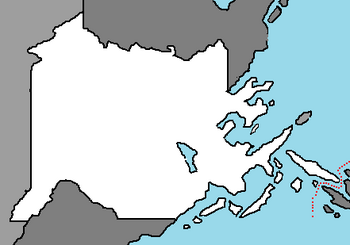Togaria
United States of Togaria Togaria | |
|---|---|
|
Flag | |
 | |
| Capital | Esmiteraan |
| Official languages | Togarian |
| Recognised national languages | Qolaysian, Quetanan, Emmirian |
| Ethnic groups | Togarian, Jabanesian, Paransian |
| Government | |
| Zophar Lawson | |
| Population | |
• 2020 estimate | 14,234,000 |
| Date format | mm-dd-yyyy |
The United States of Togaria, most commonly known as Togaria, is a nation in the Coalition of Crown Albatross located on the continent of Adula, bordered by Zalluabed, Semalia, and maritime borders with Ascacia and Qolaysia. The Togarian mainland and the Togarian/Qolaysian archipelago has been a valuable region for trade since at least the 8th century when the Emmirian and later Skithan Empires traded with entities from mainland Adula and the subcontinent. Local rulers gradually absorbed foreign influences from the early centuries and Togarian and Qolaysian kingdoms flourished. Sunni traders and Sufi scholars brought Islam, while Verdusans and Euronians introduced Christianity through colonisation.
Although sometimes interrupted by the Quetanans, Durnstaal, and even Yuaneze, the Togarians were the foremost colonial power for much of their 350-year presence in the archipelago. The concept of "Qolaysia" as a nation-state emerged in the early 20th century and the country proclaimed its independence in 1945, but it was not until 1949 that the Togarians recognised Qolaysia's sovereignty following the Semalia Gulf War between the two and the outset of the World War. In recent years, tensions between Togaria and Qolaysia have escalated over the resource-rich and strategic location of the archipeligo, resulting in numerous clashes including the ongoing Togana War.
Togaria is a member of multiple international organizations, such as the Southeastern International Association of Adula and the Coalition of Crown Albatross.

